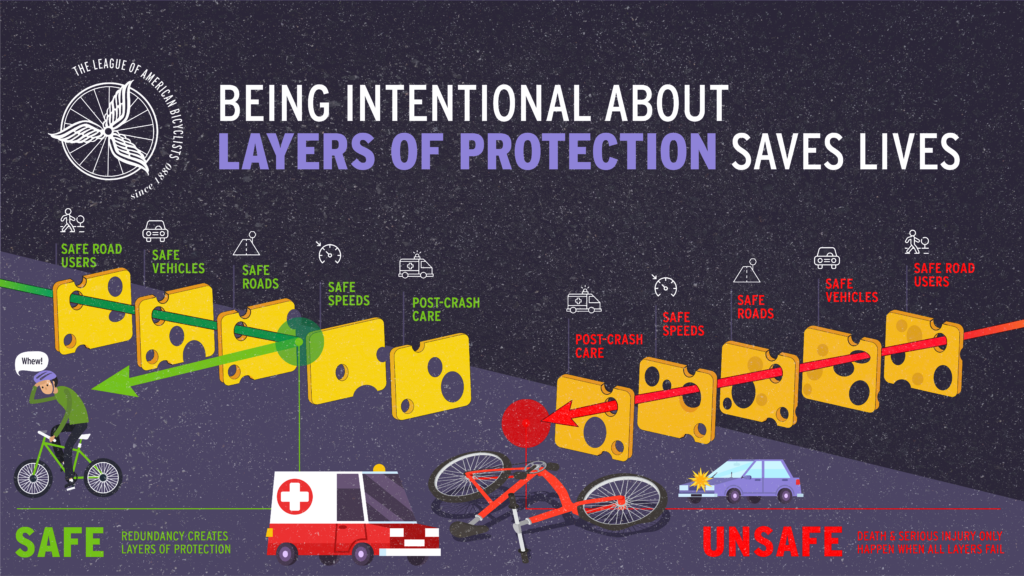DISCOVER YOUR LOCAL BICYCLING COMMUNITY
Find local advocacy groups, bike shops, instructors, clubs, classes and more!
Should Vehicles Help Drivers Not Speed?
The National Transportation Safety Board (NTSB) recently made headlines for recommending that the National Highway Traffic Safety Administration (NHTSA) should require all new vehicles to have intelligent speed assistance systems as a standard. This recommendation was made in response to a fatal crash where a driver drove a 2018 Dodge Challenger at 103 mph through a red light and hit a Toyota Sienna minivan. The crash killed nine people, including all seven occupants of the minivan, and the driver and passenger in the Dodge Challenger.
While the driver of the Dodge Challenger was intoxicated by cocaine and phencyclidine (also known as PCP), the NTSB found that the driver’s speeding behavior could have been mitigated by Intelligent Speed Assistance (ISA). The driver was a repeat speeder, with a history of speeding offenses, who sought a vehicle marketed on its capacity to speed and which had no technology to help a driver follow the speed limit.

In a Safe System Approach, redundancy and layers of protection are key ways that the public sector mitigates the harms caused by individual behavior such as driving while intoxicated or distracted. The NTSB found that ISA would have provided a layer of protection and redundancy in this crash and others that involve high rates of speed.
In the League of American Bicyclists’ Slow Roads Save Lives campaign we have asked drivers to make a pledge embracing slower roads, and to “[drive] with an intention of speed limit compliance at all times and recognizing that I control the speed of my vehicle.”
Intelligent Speed Assistance (ISA) is a technology that helps individual drivers follow through on their intention of speed limit compliance. ISA works by providing information to a driver about the current speed limit and the driver’s compliance with the current speed limit. Information is conveyed in one or more of the following ways:
- A visual cue may indicate compliance or noncompliance — just as many vehicles will provide a visual cue that a driver is driving in a more or less eco-friendly manner.
- An audible cue may indicate non-compliance — just as vehicles are currently required to do for seatbelt use by drivers.
- A haptic cue may indicate non-compliance — meaning the accelerator pedal will become harder to press, providing a physical cue that the driver is going too fast.
- A speed control function may indicate non-compliance — just as an e-bike has a speed control function that limits electric power delivery above the legal speed based on the e-bike’s classification, this control function would limit power delivery above the speed limit or a threshold above the speed limit. Many vehicles are currently electronically limited to speeds of 155 mph based on a German “gentlemen’s agreement” to limit speeds on the autobahn, which famously lacks a speed limit in many segments.
ISA helps drivers not speed by providing them contextual information. If there is a “speed trap” due to a sudden change in speed limit, then ISA will be aware of the speed limit change and provide the driver a cue to slow down.
ISA never issues tickets, never imposes fines and fees, and never initiates a traffic stop that can escalate into traffic violence.

Last year, ISA became standard equipment in all new vehicles sold in the European Union. Under their standard, “[t]he driver is always in control and can easily override the ISA system.” The estimated cost of ISA as standard equipment is between about $50-250 per vehicle.
In the United States, ISA is currently available in some vehicles and as part of some optional packages, but data is limited on its uptake. The NTSB recommended standardization as a method of ensuring adoption, but also reiterated its 2018 recommendation of incentivizing adoption through publicizing the existence of ISA through NHTSA’s New Car Assessment Program.
ISA is a tool that helps drivers not speed. The NTSB has said we should make it standard so more people can use it. The League agrees and looks forward to a fact-based discussion about how drivers can be supported in their intention to follow the law through technology. About 30% of traffic deaths each year involve speeding and ISA would provide drivers a tool so that they don’t contribute to that statistic.